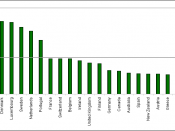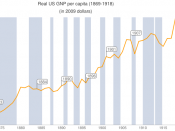The level of Macroeconomics is concerned either on with the economy as a whole or with the basic subdivisions of aggregates - such as government, household and business sec-tors - which meke up the economy. An aggregate is a collection of the specific economics units which are treated as if they were one unit. Macroeconomics overviews all economy by generally outlining the mainest aggregates which construct the economy. That's why such words as total, general are always used in Macroeconomics. That is the part of eco-nomics concerned with the economy as a whole; with such major aggregates as house-holds, business and governmental sectors and with totals for the ec. So, tha basical Macro-economics indicators are: Gross National Product (GNP), Price level, Interest Reate and Employment.
GNP: It is generally agreed that the best available indicator of economy health is its annual output of goods and services, or so-called aggregate output.
This is called GNP and is de-fined as the total market value of all final goods & services produced in ec in one year. The definition of the GNP is very explicit and merits comments. First, GNP measures the market value of annual output. Second, GNP is a monetary measure. To measure all output accurately we should count all goods and services only once. That is why GNP increasereaseludes only final goods and services and ignores transactions involving intermediate goods and services. By Final meant such goods and services that are purchased for final use and not to be sold in future (resale), or other processing or manufac-turing. Directly opposite goods and services are called intermediate. Intermediate goods and services are excluded from GNP cause it could involve double countintg. Alot of nonproduction transactions must be carefully excluded fron GNP: financial transaction (public transfer payments - to increasereaselude them to...


